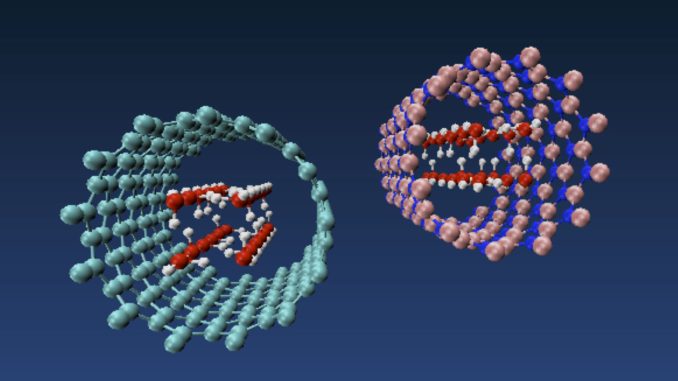
Nanotubes Change The Shape of Water
Rice University engineers show how water molecules square up in nanotubes
Rice University engineers show how water molecules square up in nanotubes
First, according to Rice University engineers, get a nanotube hole. Then insert water. If the nanotube is just the right width, the water molecules will align into a square rod.
Rice materials scientist Rouzbeh Shahsavari and his team used molecular models to demonstrate their theory that weak van der Waals forces between the inner surface of the nanotube and the water molecules are strong enough to snap the oxygen and hydrogen atoms into place.
Shahsavari referred to the contents as two-dimensional “ice,” because the molecules freeze regardless of the temperature. He said the research provides valuable insight on ways to leverage atomic interactions between nanotubes and water molecules to fabricate nanochannels and energy-storing nanocapacitors.
A paper on the research appears in the American Chemical Society journal Langmuir.
Shahsavari and his colleagues built molecular models of carbon and boron nitride nanotubes with adjustable widths. They discovered boron nitride is best at constraining the shape of water when the nanotubes are 10.5 angstroms wide. (One angstrom is one hundred-millionth of a centimeter.)
The researchers already knew that hydrogen atoms in tightly confined water take on interesting structural properties. Recent experiments by other labs showed strong evidence for the formation of nanotube ice and prompted the researchers to build density functional theory models to analyze the forces responsible.
Shahsavari’s team modeled water molecules, which are about 3 angstroms wide, inside carbon and boron nitride nanotubes of various chiralities (the angles of their atomic lattices) and between 8 and 12 angstroms in diameter. They discovered that nanotubes in the middle diameters had the most impact on the balance between molecular interactions and van der Waals pressure that prompted the transition from a square water tube to ice.
“If the nanotube is too small and you can only fit one water molecule, you can’t judge much,” Shahsavari said. “If it’s too large, the water keeps its amorphous shape. But at about 8 angstroms, the nanotubes’ van der Waals force starts to push water molecules into organized square shapes.”
He said the strongest interactions were found in boron nitride nanotubes due to the particular polarization of their atoms.
Shahsavari said nanotube ice could find use in molecular machines or as nanoscale capillaries, or foster ways to deliver a few molecules of water or sequestered drugs to targeted cells, like a nanoscale syringe.
Lead author Farzaneh Shayeganfar, a former visiting scholar at Rice, is an instructor at Shahid Rajaee Teacher Training University in Tehran, Iran. Co-principal investigator Javad Beheshtian is a professor at Amirkabir University, Tehran.
Supercomputer resources were provided with support from the National Institutes of Health and an IBM Shared Rice University Research grant.
Hybrid nanostructures hold hydrogen well: http://news.rice.edu/2016/10/24/hybrid-nanostructures-hold-hydrogen-well/
Multiscale Materials Laboratory (Shahsavari Lab): http://rouzbeh.rice.edu/
George R. Brown School of Engineering: http://engineering.rice.edu
Rice Department of Civil and Environmental Engineering: www.ceve.rice.edu
Rice Department of Materials Science and NanoEngineering: https://msne.rice.edu







Leave a Reply